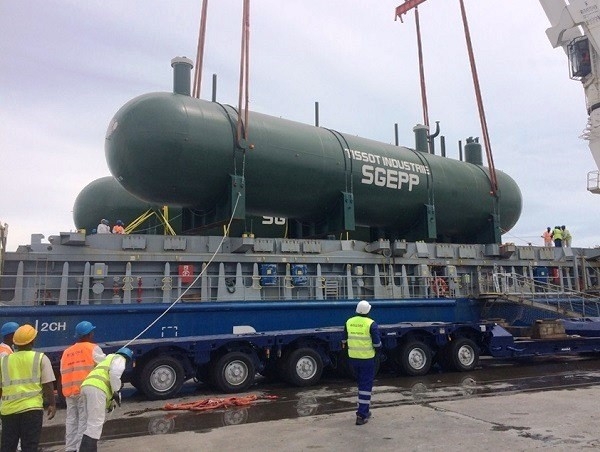
Bolloré Logistics in transportation of two tanks from France to Gabon
September 13, 2017: The Industrial Projects France teams carried out the on-site transport of two tanks from the boiler company Tissot Industrie from France to Owendo, in Gabon. The “cigars” of 108 tons each, 27 m length, 5 m in diameter and with a capacity of 160 cbm, were ordered by a storage tank systems […]

September 13, 2017: The Industrial Projects France teams carried out the on-site transport of two tanks from the boiler company Tissot Industrie from France to Owendo, in Gabon.
The “cigars” of 108 tons each, 27 m length, 5 m in diameter and with a capacity of 160 cbm, were ordered by a storage tank systems for Petroleum Products Company in Gabon. “This project highlighted many synergies within the Group. The technical solution presented by our supplier for the sarcophagus has stood out from the start of the studies and the know-how deployed by our two groups in the execution phase made it possible to complete this operation for the greatest satisfaction of our customers,” says Elisabeth Nicolas, Project Manager at Bolloré Logistics' Industrial Projects Division.
The project started with the transfer of these two parcels between the assembly workshop and the painting hall of the Tissot Company, within the port of St-Nazaire. For this, the transporter used a trailer 12 modular lines with a capacity of 120 tons with a tractor of a capacity of 650 to 1,200 CH with hydraulic box.
The two tanks were then routed along the chartered vessel. The trip took more than three weeks before reaching the port of Owendo in Gabon.
The local side was the one that asked for the biggest involvement with the transit, shipping, and Hygiene-Safety-Environment (HSE) teams of Bolloré Transport & Logistics in Gabon who provided all the logistical assistance around the transport and lifting operators, such as the parking of tanks in the port of Owendo, the organization of escorts for the exceptional convoy including the mapping of the route, the mobilization of cranes, trolleys, nacelles and sling teams.
One of the delicate points was the installation of the two tanks inside their sarcophagus.
Indeed, the site imposed several constraints: the impossibility of positioning cranes for lifting around the sarcophagus, of handling the ground as the entrance as the sarcophagus was raised by 2 m and finally of handling the elements on the bed of sand inside the sarcophagus.
After a phase of studies integrating all the protagonists of the project, a solution was found combining two know-how: the shift and the hoisting.
The tanks were first lifted and then suspended with four linear hydraulic winches with a capacity of 70 tons, fixed on two beams placed 8 m high on the two walls of the sarcophagus. These were then ripped on tracks installed on the sarcophagus. On the ground, the tanks were also ripped using 50 and 200-ton slip tracks and associated push-pulls to allow them to enter the sarcophagus and finally to be placed on their sand bed thanks to linear hydraulic winches.

